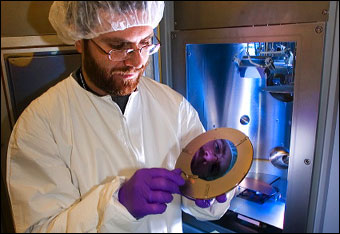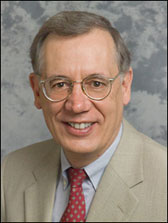Scientists Highlight Nanotech Applications at Media Roundtable
March 3, 2008
New ways to deliver drugs directly to tumor cells without poisoning the rest of the body
Beach umbrellas that absorb sunlight and allow you to plug in your laptop or cell phone
Quantum dots that produce multiple electrons per photon of absorbed light, increasing the efficiency of solar energy

Brookhaven's Center for Functional Nanomaterials serves as a focal point for advanced materials study in the northeastern United States.
These are just some of the high-tech nanoscience applications reporters learned about at a special session hosted by the National Nanotechnology Coordination Office (NNCO) during the annual meeting of the American Association for the Advancement of Science in Boston, February 15, 2008. The session, organized by John Carter of the U.S. Department of Energy's (DOE) Brookhaven Site Office and Audrey Haar of NNCO, brought reporters face-to-face with four of America's foremost nanotechnology experts for a wide-ranging discussion on nanotechnology applications in medicine and energy.
The aim, said Carter, was to highlight the role of the federal government in supporting nanotechnology research through the National Nanotechnology Initiative (NNI) and its member agencies, including DOE. "We have some very exciting research going on at the DOE Nanoscale Science Research Centers, in academia, and in industry." Carter said, "The AAAS meeting, which attracts hundreds of science reporters from all over the country and the world, was an ideal venue to present this work and shine a spotlight on the role of DOE and other NNI agencies in funding basic research and supporting the transition of promising technologies to the marketplace."
Altaf (Tof) Carim of the DOE Office of Science and co-chair of the Nanoscale Science, Engineering and Technology (NSET) Subcommittee of the National Science and Technology Council kicked off the discussion with an overview of NNI as an interagency effort to coordinate the nanoscience research already under way across 25 agencies within the federal government.
Some of the most exciting nanoscale research is taking place in medicine. Guest speaker Robert Langer of the Massachusetts Institute of Technology described his research at the interface of biotechnology and materials science, including work to develop one-centimeter-square grids that contain 100 nanoliter-volume wells. These "pharmacy on a chip" grids could be implanted, or made into pills, to carry 100 doses of a drug (or 100 different drugs) into the body in a single application, with each well opening remotely in a time-release manner when a tiny electrical current is applied. The same technique could also be used to develop implantable sensors for glucose, for example, to spare diabetics the need for constant blood testing.
Langer, whose research has been supported in part by the National Science Foundation and the National Cancer Institute, also described attaching nanoparticles to cancer-fighting drugs to both help the drug molecules evade the body's immune system and find their way directly to their target cells. Such targeted therapy, he said, "would be more effective and less expensive [than conventional chemotherapy] because you'd be directing all of the drug (at much lower doses) to the cells you want to treat instead of dumping a whole lot of drug into the whole body."
Langer's final example - though it was clear he could have gone on - was a new kind of adhesive modeled on the sticky nanostructured protrusions on gecko toes. Though others have tried modeling gecko nanopillars before, Langer said his group is the first to create a nanopillar adhesive that sticks very well when wet, making it ideal for surgical applications such as hernia repair.
Next up was Emilio Mendez, Director of Brookhaven's Center for Functional Nanomaterials (CFN), who presented a variety of ways researchers at DOE Office of Science Nanoscale Science Research Centers are addressing challenges in meeting our nation's energy needs. He pointed out the enormous waste in today's energy production balance sheet, due to inefficiency, as well as the geopolitical instability of our main energy sources.

Emilio Mendez
"The solution," he said, "is very simple: use less energy, use it more efficiently, and look for alternatives to fossil fuels. Nanoscience can help in all of these areas."
For example, research at Brookhaven has shown that adding gold nanoparticles to the platinum catalysts currently used in fuel cells can increase the efficiency and stability of the platinum. This results in lower cost (because you don't have to replace the expensive platinum) and higher energy yield.
"But we don't really understand why it works," Mendez said. "More understanding is necessary. Is gold unique? Can we use other materials? That's the beauty of the kind of basic research we do at the national labs. We can ask these questions and do experiments to look for ways to understand the process and optimize the catalytic properties."
In the search for alternative energy sources, nanoscience may offer breakthrough possibilities. For example, it is widely believed that because a single photon of light produces a single electron in traditional silicon solar cells, there is a theoretical limit to how efficient these solar cells can be - around 30 percent. But engineering new kinds of solar cells at the nanoscale may allow scientists to overcome this limit. Research using quantum dots at DOE's National Renewable Energy Laboratory has shown that it may be possible for one photon of light to produce more than one electron, Mendez said.
DOE scientists are also experimenting with silicon nanowires, which produce electricity from sunlight without using plastic. This could improve efficiency because the polymers used in organic solar cells trap some of the electrons generated, reducing the current. "In silicon nanowires, there is not much time for the electrons to become trapped," Mendez said.
DOE labs have also devised new ways to assemble and study nanomaterials, Mendez said. Scientists at Brookhaven are working on two main techniques: building nanomaterials from templates and getting them to self-assemble. One of the most exciting recent developments in self-assembly is a technique using complementary strands of DNA, to bring nanoparticles together to form stable 3-D crystals. Such ordered, crystalline structures would be essential for producing functional materials that take advantage of the unique nanoscale properties such as enhanced magnetism, improved catalytic activity, or new optical properties.
Brookhaven's complementary facilities, particularly the National Synchrotron Light Source and the proposed NSLS-II, as well as facilities at other DOE nanocenters, will help scientists better understand these nanoscale materials and properties and ensure their uniformity, consistency, and reproducibility.
Consistency will be essential for materials to be used in a commercial setting, as demonstrated by the session's final speaker, Rick Hess, President and Chief Executive Officer of Konarka Technologies Inc., based in Lowell, Massachusetts. Hess described his company's development of organic solar cells, manufactured by printing "inks" made of light-absorbing polymers and nanoscale buckyballs onto sheets of plastic using techniques originally developed to produce Polaroid film. The polymers generate the current and the buckyballs carry it to electrodes for use.
So far, these cells don't have nearly the efficiency of silicon solar. But they are extremely flexible and lightweight, and the manufacturing process is much less costly than for traditional solar. Those properties make them extremely attractive for a wide range of applications where traditional solar wouldn't even be possible, Hess said.
For example, picture yourself sitting on the beach under a shady umbrella - only the surface of the umbrella is made of flexible plastic capable of generating electricity as it screens you from the sun's harmful rays. How much electricity? Enough to plug in your laptop or charge up your cell phone, for sure, Hess said. And they are working on ways to improve efficiency.
To ensure consistency and quality, Konarka relies on facilities supported by the NNI at the University of Massachusetts at Lowell "to visualize the materials to be sure that we have created the structure we wanted and that the mix is right," Hess said.
In addition to powering beach umbrellas, plastic solar cells could be used in tents, awnings, stadiums, carports, or to bring electrical power to people living off the mainstream grid. The materials could also be used for wireless sensors for temperature and humidity, or even as shelf-life labels on grocery packages, Hess said.
The films can be made in any color, allowing users to specify which wavelengths of light (colors) are absorbed and which pass through - which might be useful for applications in wastewater treatment, where certain wavelengths are needed for biodegradation of wastes while others could be absorbed to generate electricity.
"It's amazing to see the many ways nanotechnology may find its way into our lives," DOE's Carter summed up. "I'm excited to be a part of the research effort that's making these important strides in addressing problems of critical importance to our nation and the world."
2008-570 | INT/EXT | Newsroom









